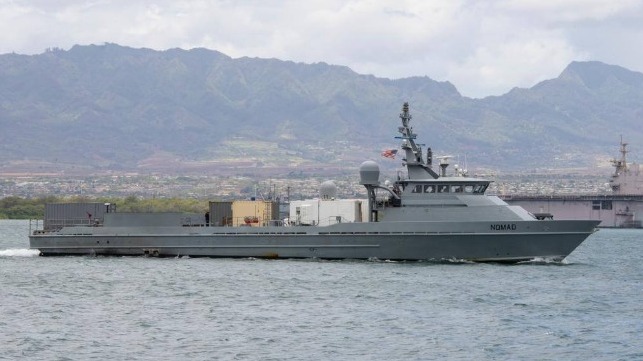CNO: Uncrewed Platforms Contribute to Live-Fire Sinking at RIMPAC

Uncrewed vessels are playing a prominent role at the U.S. Navy's flagship Rim of the Pacific exercise this year. This year, more than 30 experiments have been planned at RIMPAC using unmanned platforms from U.S. and partner nations, including recent innovations like crewed-uncrewed teaming.
“Integrating these nested unmanned technologies, in a distributed warfighting posture, during live-fire sink exercises absolutely help mature our concept of operations as well as inform our understanding of which technologies are the most combat capable,” said Chief of Naval Operations Adm. Mike Gilday during a visit to the month-long maneuvers.
RIMPAC 2022 has drawn the attendance of twenty-six nations, three dozen warships, 25,000 personnel - and four U.S. Navy uncrewed vessels. The ex-Operation Overlord crew boats Nomad and Ranger are on hand, repainted in haze gray, as well as the ex-DARPA trimarans Sea Hunter and Seahawk. All four are working together under one unit, operating with the joint oversight of Pacific Fleet's Surface Development Squadron One and the NAVSEA program office for Unmanned Maritime Systems, PMS-406.
The team says that these prototypes are operating side-by-side with crewed vessels, carrying payloads, providing intelligence, and gathering data to help figure out how they will function in the larger fleet.
“The integration of autonomous USVs with manned combatants will give fleet commanders much-needed enhancements to maritime domain awareness, thereby increasing decision speed and lethality in surface warfare,” said Capt. Scot Searles, program manager of PMS 406.
Uncrewed systems have participated in exercises before, but the involvement of four different oceangoing vessels operating autonomously or by manned teams is unprecedented for the U.S. Navy.
“We need to continue to put ourselves in a position where we can scale and really make unmanned assets on, below and above the sea an important part of the fleet,” said Adm. Gilday. “It’s no longer a luxury. It’s a necessity if we want to operate in a distributed manner.”
